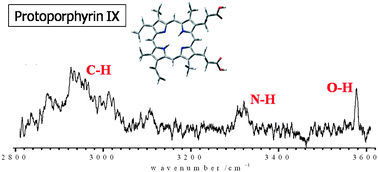Double-resonance spectroscopy of the jet-cooled free base and Cu(ii) complex of protoporphyrin IX
Abstract
The excited-state dynamics of porphyrins, and related compounds, impact on their applications as photosensitizers for tumor-targeting

* Corresponding authors
a School of Chemistry, University of Bristol, Cantock's Close, Bristol, UK
b
Department of Chemistry, University of Leicester, Leicester, UK
E-mail:
ah242@leicester.ac.uk
Fax: +44 (0)116 252 3789
Tel: +44 (0)116 252 2099
c Physical and Theoretical Chemistry Laboratory, University of Oxford, South Parks Road, Oxford, UK
The excited-state dynamics of porphyrins, and related compounds, impact on their applications as photosensitizers for tumor-targeting

 Please wait while we load your content...
Something went wrong. Try again?
Please wait while we load your content...
Something went wrong. Try again?
J. M. Beames, A. J. Hudson, T. D. Vaden and J. P. Simons, Phys. Chem. Chem. Phys., 2010, 12, 14076 DOI: 10.1039/C0CP00874E
To request permission to reproduce material from this article, please go to the Copyright Clearance Center request page.
If you are an author contributing to an RSC publication, you do not need to request permission provided correct acknowledgement is given.
If you are the author of this article, you do not need to request permission to reproduce figures and diagrams provided correct acknowledgement is given. If you want to reproduce the whole article in a third-party publication (excluding your thesis/dissertation for which permission is not required) please go to the Copyright Clearance Center request page.
Read more about how to correctly acknowledge RSC content.
 Fetching data from CrossRef.
Fetching data from CrossRef.
This may take some time to load.
Loading related content
